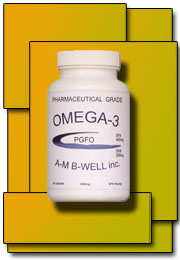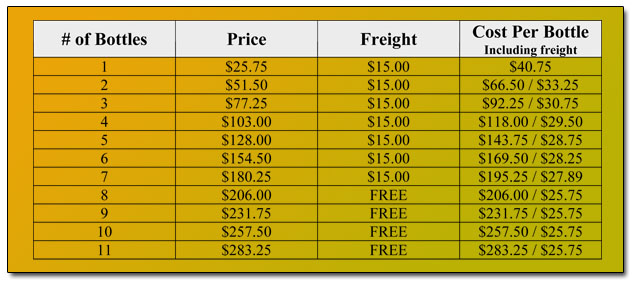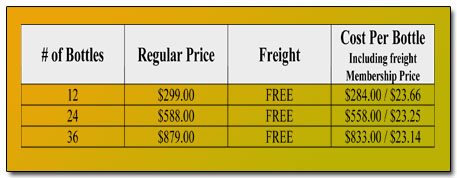




Warmest greetings to all of my valued Customers, Case Club Members and Friends receiving this September edition of our monthly newsletter!!
As always I hope that this month has brought you and yours wonderful health and happiness!
This month, in our "From the Desk" section there is an amazing article on how consumption of Omega-3 fatty acids benefits your eyes and vision.
But first, let's start by taking a look at how fish oil increases benefits of exercise for the elderly.
Please enjoy!!!
Sincerely,
Anne-Marie
Fish oil may double benefits of exercise for elderly
Eating a portion of oily fish such as salmon or mackerel three times a week could help to protect the muscles from deterioration in old age by doubling the benefits of exercise, experts claim.
A combination of regular doses of fish oil and gym exercises improved the muscular strength of a group of women in their late sixties by 20 per cent in a new study.
A control group who took part in the twice-weekly, 30-minute exercise sessions but did not take fish oil increased their muscle power by 11 per cent.
Over the course of the 12-week study, those who took the fish oils also made noticeably larger improvements in tests of their balance, walking speed and time taken to get up from a chair.
Speaking at the British Science Festival, researchers from Aberdeen University said the difference could be down to the effects of DHA and EPA, types of Omega 3 fatty acid found in fish oil that have anti-inflammatory properties. As a normal part of ageing, muscle size reduces by between 0.5 per cent and two per cent a year in older people, a condition known as sarcopenia.
After our mid-thirties our body’s ability to build muscle through exercise alone begins to diminish, meaning it is difficult for older people to resist muscle wastage. Researchers said the fish oils could work by combating the low-level inflammation that is typical in older people and hampers the ability of the muscles to build power and mass. Dr Stuart Gray said: “We’re trying to make older muscle adapt like younger muscle, and that’s where we think fish oil can come in.”
source: http://www.telegraph.co.uk
Click here to visit the A-M B-Well Inc. order page and get your PGFO today!!!


Eye Benefits of Omega-3 Fatty Acids
You may find it hard to believe that fat is essential to your health, but it's true. Without fat, our bodies can't function properly. And without the proper kinds of fats in our diet, our eye health also may suffer.
Fatty acids are the "building blocks" of fat. These important nutrients are critical for the normal production and functioning of cells, muscles, nerves and organs. Fatty acids also are required for the production of hormone-like compounds that help regulate blood pressure, heart rate and blood clotting.
Some fatty acids — called essential fatty acids (EFAs) — are necessary to our diet, because our body can't produce them. To stay healthy, we must obtain these fatty acids from our food.
Two types of EFAs are omega-3 fatty acids and omega-6 fatty acids. Studies have found that omega-3 fatty acids, in particular, may benefit eye health.
Omega-3 fatty acids include docosahexaenoic acid (DHA), eicoapentaenoic acid (EPA) and alpha-linolenic acid (ALA).
Omega-3 Fatty Acids and Infant Vision Development
A number of clinical studies have shown omega-3 fatty acids are essential for normal infant vision development.
DHA and other omega-3 fatty acids are found in maternal breast milk and also are added to some supplemented infant formulas. Omega-3 supplemental formulas appear to stimulate vision development in infants.
According to an analysis of several studies conducted by researchers at Harvard School of Public Health and published in the journal Pediatrics, the authors found that healthy pre-term infants who were fed DHA-supplemented formula showed significantly better visual acuity at 2 and 4 months of age, compared with similar pre-term infants who were fed formula that did not contain the omega-3 supplement.
Adequate amounts of DHA and other omega-3 fatty acids in the diet of pregnant women also appears to be important in normal infant vision development.
In a study published in the American Journal of Clinical Nutrition, Canadian researchers found that infant girls whose mothers received DHA supplements from their fourth month of pregnancy until delivery were less likely to have below-average visual acuity at 2 months of age than infant girls whose mothers did not receive the omega-3 supplements.
Adult Eye Benefits of Omega-3 Fatty Acids
Several studies suggest omega-3 fatty acids may help protect adult eyes from macular degeneration and dry eye syndrome. Essential fatty acids also may help proper drainage of intraocular fluid from the eye, decreasing the risk of high eye pressure and glaucoma.
In a large European study published in 2008, participants who ate oily fish (an excellent source of DHA and EPA omega-3 fatty acids) at least once per week had half the risk of developing neovascular ("wet") macular degeneration, compared with those who ate fish less than once per week.
Also, a 2009 National Eye Institute (NEI) study that used data obtained from the Age-Related Eye Disease Study (AREDS) found participants who reported the highest level of omega-3 fatty acids in their diet were 30 percent less likely than their peers to develop macular degeneration during a 12-year period.
Omega-3 fatty acids also have been found to reduce the risk of dry eyes. In a study of more than 32,000 women between the ages of 45 and 84, those with the highest ratio of (potentially harmful) omega-6 fatty acids to beneficial omega-3 fatty acids in their diet (15-to-1) had a significantly greater risk of dry eye syndrome, compared with the women with the lowest ratio (less than 4-to-1). The study also found that the women who ate at least two servings of tuna per week had significantly less risk of dry eye than women who ate one or fewer servings per week.
Omega-3 fatty acids also may help treat dry
eyes. In a recent study of dry eyes induced in mice, topical application
of the omega-3 fatty acid ALA led to a significant decrease in dry eye
signs and inflammation associated with dry eye.
Omega-3 Foods
While both omega-3 and omega-6 fatty acids are important to health, the balance of these two types of EFAs in our diet is extremely important. Most experts believe the ratio of omega-6 to omega-3 fatty acids in a healthy diet should be 4-to-1 or lower.
Unfortunately, the typical American diet, characterized by significant amounts of meat and processed foods, tends to contain 10 to 30 times more omega-6 than omega-3 fatty acids. This imbalance of omega-6 ("bad") fatty acids to omega-3 ("good") fatty acids appears to be a contributing cause of a number of serious health problems, including heart disease, cancer, asthma, arthritis and depression.
One of the best steps you can take to improve your diet is to eat more foods that are rich in omega-3 fatty acids and fewer that are high in omega-6 fatty acids.
The best food sources of beneficial omega-3 fatty acids are cold-water fish, which are high in both DHA and EPA. Examples include sardines, herring, salmon and tuna. Wild-caught varieties usually are better than "farmed" fish, which typically are subject to higher levels of pollutants and chemicals.
The American Heart Association recommends a minimum of two servings of cold-water fish weekly to reduce the risk of cardiovascular disease, and many eye doctors likewise recommend a diet high in omega-3 fatty acids to reduce the risk of eye problems.
If you aren't a fish lover, another way to make sure your diet contains enough omega-3s it to take fish oil supplements. These are available in capsule and liquid form, and many varieties feature a "non-fishy" taste.
Other good sources of omega-3 fatty acids include flaxseeds, flaxseed oil, walnuts and dark green leafy vegetables. However, your body cannot process the ALA omega-3 fatty acids from these vegetarian sources as easily as the DHA and EPA omega-3 fatty acids found in fish.
To reduce your intake of omega-6s, avoid fried and highly processed foods. Many cooking oils, including sunflower oil and corn oil, are very high in omega-6 fatty acids. High cooking temperatures also create harmful trans-fatty acids, or "trans-fats."
Trans fats interfere with the body's absorption of beneficial omega-3 fatty acids and may contribute to a number of serious diseases, including cancer, heart disease, atherosclerosis (hardening of the arteries), high blood pressure, diabetes, obesity, arthritis and immune system disorders.
Currently, there is no Recommended Dietary Allowance (RDA) for omega-3 fatty acids. But, according to the American Heart Association, research suggests daily intakes of DHA and EPA (combined) ranging from 500 milligrams (0.5 gram) to 1.8 grams (either from fish or fish oil supplements) significantly reduces cardiac risks. For ALA, daily intakes of 1.5 to 3 grams (g) seem to be beneficial.
For a more nutritious diet and potentially better eye health, try these simple changes:
- Replace cooking oils that are high in omega-6 fatty acids with olive oil, which has significantly lower levels of omega-6 fatty acids.
- Eat plenty of fish, fruits and vegetables.
- Avoid hydrogenated oils (found in many snack foods) and margarine.
- Avoid fried foods and foods containing trans fats.
- Limit your consumption of red meat.
Choosing a healthy diet that includes a variety of foods with plenty of omega-3 fatty acids and limiting your intake of potentially harmful omega-6 fatty acids will significantly increase your odds of a lifetime of good vision and vibrant health.
source: http://www.allaboutvision.com
Click here to visit the A-M B-Well Inc. order page and get your PGFO today!!! -






5 ml. = 5 capsule
125 ml. / 4 ozs. per bottle
CLICK
HERE
to read label ingredients

90 capsules per bottle
CLICK
HERE
to read label ingredients




A-M B-Well™ Omega-3 PGFO has been third party tested according to the parameters established by the Council for Responsible Nutrition (“CRN”) and the World Health Organization (“WHO”) for its potency and purity by http://www.ifosprogram.com/ and receives a 5 Star rating.
Omega-3 PGFO capsules and Omega-3 Liquid Gold are identical in price, being $25.75 per bottle. Below is a chart listing the prices on the Order Page for Canada and U.S. Retail. The price shows the total price for 1 to 11 bottles with the freight included, then breaks it down by the price per bottle. 8 to 11 bottles are shipped freight-free.
The second chart called Case
Club Membership lists the prices on the Order Page for Canada and U.S.
Wholesale. This chart is to show you how much money you can save per bottle
if you order by the case (12 bottles) and also join the Case Club. You
will further note that the second chart also shows the total price for
bottles for 12, 24 and 36 bottles based on Regular and Case Club prices,
then breaks it down by the price per bottle. As you can see, you are paying
considerably less per bottle by ordering in bulk.





Case Club membership is
$25 per annum.
Club membership gives you a 5% discount on all
your case purchases for one year.
A good idea for customers purchasing 2 or more cases per year.
Visit
our Order Page and choose your Country.
You will be able to choose between Omega-3 PGFO Capsules and Omega-3 Liquid
Gold or order both together.
Warmest Regards,
Anne-Marie

